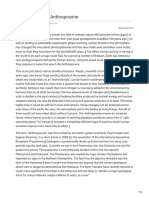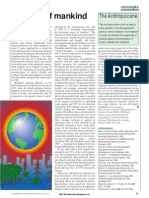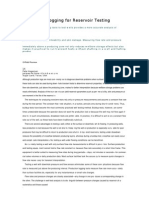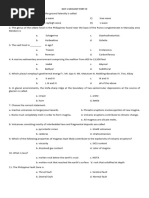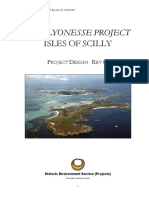0 ratings0% found this document useful (0 votes)
34 viewsAnthropocene Presentation
Anthropocene Presentation
Uploaded by
rkxqgbh5fbHumanity's impact on the planet through activities like burning fossil fuels, intensive agriculture, and widespread pollution has been significant enough that scientists propose designating a new geologic epoch called the Anthropocene. The Anthropocene represents the period in which human activity has had dramatic effects like rapidly increasing carbon dioxide levels in the atmosphere, accelerating the extinction of animal and plant species, generating huge amounts of plastic waste, and doubling nitrogen and phosphorus levels in soils through fertilizer use. Evidence of humanity's geological impacts can be found in sediment layers and glacial ice containing black carbon from fossil fuel burning.
Copyright:
© All Rights Reserved
Available Formats
Download as PDF, TXT or read online from Scribd
Anthropocene Presentation
Anthropocene Presentation
Uploaded by
rkxqgbh5fb0 ratings0% found this document useful (0 votes)
34 views20 pagesHumanity's impact on the planet through activities like burning fossil fuels, intensive agriculture, and widespread pollution has been significant enough that scientists propose designating a new geologic epoch called the Anthropocene. The Anthropocene represents the period in which human activity has had dramatic effects like rapidly increasing carbon dioxide levels in the atmosphere, accelerating the extinction of animal and plant species, generating huge amounts of plastic waste, and doubling nitrogen and phosphorus levels in soils through fertilizer use. Evidence of humanity's geological impacts can be found in sediment layers and glacial ice containing black carbon from fossil fuel burning.
Original Description:
Nsci reporting
Original Title
Anthropocene presentation
Copyright
© © All Rights Reserved
Available Formats
PDF, TXT or read online from Scribd
Share this document
Did you find this document useful?
Is this content inappropriate?
Humanity's impact on the planet through activities like burning fossil fuels, intensive agriculture, and widespread pollution has been significant enough that scientists propose designating a new geologic epoch called the Anthropocene. The Anthropocene represents the period in which human activity has had dramatic effects like rapidly increasing carbon dioxide levels in the atmosphere, accelerating the extinction of animal and plant species, generating huge amounts of plastic waste, and doubling nitrogen and phosphorus levels in soils through fertilizer use. Evidence of humanity's geological impacts can be found in sediment layers and glacial ice containing black carbon from fossil fuel burning.
Copyright:
© All Rights Reserved
Available Formats
Download as PDF, TXT or read online from Scribd
Download as pdf or txt
0 ratings0% found this document useful (0 votes)
34 views20 pagesAnthropocene Presentation
Anthropocene Presentation
Uploaded by
rkxqgbh5fbHumanity's impact on the planet through activities like burning fossil fuels, intensive agriculture, and widespread pollution has been significant enough that scientists propose designating a new geologic epoch called the Anthropocene. The Anthropocene represents the period in which human activity has had dramatic effects like rapidly increasing carbon dioxide levels in the atmosphere, accelerating the extinction of animal and plant species, generating huge amounts of plastic waste, and doubling nitrogen and phosphorus levels in soils through fertilizer use. Evidence of humanity's geological impacts can be found in sediment layers and glacial ice containing black carbon from fossil fuel burning.
Copyright:
© All Rights Reserved
Available Formats
Download as PDF, TXT or read online from Scribd
Download as pdf or txt
You are on page 1of 20
THE
ANTHROPOCENE LA TIERRA
QUINO - ROBLES - SALOLOG
PRE - ASSESSMENT
Instruction: Read the statement and write TRUE if
the statement is correct and FALSE if not.
1. Geologic time is not easy to grasp mentally because
of its magnitude.
2. The story of the earth is written in the rocks.
3. It is during Holocene epoch that man started to
disturb the balance of nature.
4. Ape man appeared and increased in number during
Piliocene epoch.
Introduction
Humanity's impact on the planet has
been profound. It is widely accepted
that our species, has had such a
significant impact on Earth and its
inhabitants that we will have a lasting
- and potentially irreversible -
influence on its systems,
environment, processes and
biodiversity.
Introduction
From fire, intensive hunting, and
agriculture, it has accelerated into
rapid climate change, widespread
pollution, plastic accumulation,
species invasions, and the mass
extinction of species-changes that
have left a permanent mark in our
planet.
The story of the earth is written in rocks. Scientists
have gradually deciphered the secrets by patiently
"reading" the records.
Earth’s History us divided into a hierarchal series of
time, referred to as the geologic time scale.
these divisions length of time, are called eons, eras,
periods, epochs, and ages.
These units are classified based on Earth’s rock
layers, or strata, and the fossils found within them.
WHAT IS ANTHROPOCENE?
Anthropocene or the Anthropocene Epoch
is an unofficial unit of geologic time, used
to describe the most recent period in
Earth’s history when human activity started
to have a significant impact on the planet’s
climate and ecosystems.
WHAT IS ANTHROPOCENE?
Anthropocene comes from the greek terms
for Human (‘anthropo’) and new (‘cene’).
To date, the Anthropocene has not been
formally adopted into geologic timescale
but has been gaining traction as a cultural
concept.
Evidence of Anthropocene
Human activity has:
01 Evidence #1
Pushed extinction rates
of animals and plants
far above the long-term
average. The Earth is on
course to see 75% of
species become extinct
in the next few
centuries if current
trends continue.
Evidence of Anthropocene
Human activity has:
02 Evidence #2
Increased levels of climate-
warming CO2 in the
atmosphere at the fastest rate
for 66m years, with fossil-fuel
burning pushing levels from
280 parts per million before
the industrial revolution to
400ppm and still rising today.
Evidence of Anthropocene
Human activity has:
03 Evidence #3
Put too much plastic in
our waterways and
oceans that microplastic
particles are now virtually
ubiquitous and plastics
will likely leave identifiable
fossil records for future
generations to discover.
Evidence of Anthropocene
Human activity has:
04 Evidence #4
Doubled the nitrogen and
phosphorous in our soils in
the past century with
fertilizer use. This is likely to
be the largest impact on the
nitrogen cycle in 2.5bn
years.
Evidence of Anthropocene
Human activity has:
05 Evidence #5
Left a permanent layer of
airborne particulates in
sediment and glacial ice
such as black carbon
from fossil fuel burning.
Evidence of Anthropocene
Summary
The earth has a long history and this is
written in rocks. Many changes happened
05
during that period. Earth surface changes,
living things disappear and new ones
appeared. The changes that happen
become the basis of dividing earth's history
into eons, eras, periods, epochs, and ages.
However many scientists argued that a new
era must be added to the previous ones.
According to them we are now in
Anthropocene epoch. This is the period
when human activities have big impact to
our ecosystem and to the planet as a whole.
THANK
YOU!
You might also like
- Earthquake Design Criteria For Subways - KueselDocument10 pagesEarthquake Design Criteria For Subways - KueselAA_BB_HHNo ratings yet
- Dam Foundation Grouting: Revised and Expanded EditionDocument10 pagesDam Foundation Grouting: Revised and Expanded EditionPaulo ZwierzikowskiNo ratings yet
- Inadequate Site InvestigationDocument32 pagesInadequate Site InvestigationIan Dalisay100% (1)
- Bogucki 1999-The Origins of Human SocietyDocument30 pagesBogucki 1999-The Origins of Human SocietyPredrag Judge Stanišić33% (3)
- LESSON 10 - The AnthropoceneDocument8 pagesLESSON 10 - The AnthropoceneDalupire, Jhonryl A.No ratings yet
- Lesson 8.2Document32 pagesLesson 8.2Paolo Xavier CoNo ratings yet
- The Anthropocene - a new epoch of geological time - 2011Document7 pagesThe Anthropocene - a new epoch of geological time - 2011nitya.toraskar24No ratings yet
- The Debate Over the AnthropoceneDocument21 pagesThe Debate Over the AnthropoceneMohd AdnanNo ratings yet
- Foley Et Al. - 2013 - The Palaeoanthropocene - The Beginnings of Anthropogenic Environmental ChangeDocument6 pagesFoley Et Al. - 2013 - The Palaeoanthropocene - The Beginnings of Anthropogenic Environmental ChangeDaniloMenezesNo ratings yet
- The Debate Over the Anthropocene by Mohd AdnanDocument21 pagesThe Debate Over the Anthropocene by Mohd AdnanMohd AdnanNo ratings yet
- The AnthropoceneDocument9 pagesThe AnthropoceneJohn JuniorNo ratings yet
- GRP1_THE ANTHROPOCENEDocument3 pagesGRP1_THE ANTHROPOCENERuellyn ArtiagaNo ratings yet
- Anthropocene PlantationoceneDocument27 pagesAnthropocene PlantationoceneMark Recar AntequisaNo ratings yet
- Sustainable Development Exam PreparationDocument10 pagesSustainable Development Exam PreparationKandlagunta Gayathri PraharshithaNo ratings yet
- Stages of AnthropocineDocument3 pagesStages of AnthropocineSumreenNo ratings yet
- How to Curb Climate Change?: On the Basis of the History of the ClimateFrom EverandHow to Curb Climate Change?: On the Basis of the History of the ClimateNo ratings yet
- The Anthropocene: Are Humans Now Overwhelming The Great Forces of Nature?Document8 pagesThe Anthropocene: Are Humans Now Overwhelming The Great Forces of Nature?Andy GarciaNo ratings yet
- The Anthropocene EssayDocument2 pagesThe Anthropocene EssayManly HonorNo ratings yet
- Introduction To Unit 3 Lesson 10Document8 pagesIntroduction To Unit 3 Lesson 10DJ GalonNo ratings yet
- Marxism and The AnthropoceneDocument22 pagesMarxism and The AnthropoceneClaudio LartigueNo ratings yet
- History of Life on Earth Part 1 of 2Document34 pagesHistory of Life on Earth Part 1 of 2TaahirahNo ratings yet
- History of Life On EarthDocument3 pagesHistory of Life On Earthcabusorapauline5No ratings yet
- Anthropocene An Epoch of Fear or HopeDocument6 pagesAnthropocene An Epoch of Fear or HoperagersthemeNo ratings yet
- BiogeographyDocument61 pagesBiogeographyTasebe GetachewNo ratings yet
- Crutzen2002 PDFDocument1 pageCrutzen2002 PDFDaniel David ArangurenNo ratings yet
- THE ANTHROPOCENE-WPS OfficeDocument10 pagesTHE ANTHROPOCENE-WPS Officesamemerald01No ratings yet
- Geology of MankindDocument2 pagesGeology of MankindAriadne Costa Da MataNo ratings yet
- Hyperspeed EvolutionDocument2 pagesHyperspeed EvolutionAdvika WarrierNo ratings yet
- Oxygen Fluctuations History ofDocument4 pagesOxygen Fluctuations History ofMichael Grant WhiteNo ratings yet
- History of Life On Earth Part 1 of 2Document34 pagesHistory of Life On Earth Part 1 of 2api-202349222No ratings yet
- Earth Science Waq2 WK 1 3fDocument20 pagesEarth Science Waq2 WK 1 3fJOVITA SARAOSNo ratings yet
- 03 - Anthropocene2007Document9 pages03 - Anthropocene2007Gabriel Leonardo Tacchi NascimentoNo ratings yet
- Lewis Francis-Denny - AoW - Anthropocene EpochDocument4 pagesLewis Francis-Denny - AoW - Anthropocene Epoch25francisdennylNo ratings yet
- AnthropoceneDocument14 pagesAnthropoceneapi-381671671No ratings yet
- The Anthropocene AgeDocument8 pagesThe Anthropocene AgeCee VeeNo ratings yet
- '2.15 Mass Extinction'Document12 pages'2.15 Mass Extinction'fathy aliNo ratings yet
- Crutzen Stoermer AnthropoceneDocument2 pagesCrutzen Stoermer AnthropoceneRainNo ratings yet
- Environmental ArchaeologyDocument5 pagesEnvironmental Archaeologywouterbuis2005No ratings yet
- Earth and Life Science Q1 Lp14Document6 pagesEarth and Life Science Q1 Lp14Cris PaoloNo ratings yet
- BTS 05Document13 pagesBTS 05Rajni KumariNo ratings yet
- RP Lagbas VallenteDocument2 pagesRP Lagbas VallenteNatasha LagbasNo ratings yet
- Phanerozoic Eon:: Cenozoic EraDocument4 pagesPhanerozoic Eon:: Cenozoic EraXiexieNo ratings yet
- 阅读0910P5P6Document8 pages阅读0910P5P6wyandaoshica3No ratings yet
- TODOS Antropoceno ReflexoesDocument29 pagesTODOS Antropoceno ReflexoesJackson Vinicius OliveiraNo ratings yet
- Historical Geology and Geologic Time and Youtube Video "A Brief History of Geologic Time"Document3 pagesHistorical Geology and Geologic Time and Youtube Video "A Brief History of Geologic Time"Venesse Aulga AbellanosaNo ratings yet
- Living in the Anthropocene: Earth in the Age of HumansFrom EverandLiving in the Anthropocene: Earth in the Age of HumansRating: 2.5 out of 5 stars2.5/5 (4)
- GENERAL BIOLOGY 2 - Evolution and Origin of DiversityDocument10 pagesGENERAL BIOLOGY 2 - Evolution and Origin of DiversitySandraNo ratings yet
- Emphasis On The Overall Conditions Present During The Specific Geologic Period Geological Period: Precambrian ADocument3 pagesEmphasis On The Overall Conditions Present During The Specific Geologic Period Geological Period: Precambrian AColline AtanacioNo ratings yet
- English QuestionsDocument2 pagesEnglish QuestionsLara Velasco Katherin RaquelNo ratings yet
- SILVA, C. M. ARBILLA, G. Antropoceno: Os Desafios de Um Novo MundoDocument29 pagesSILVA, C. M. ARBILLA, G. Antropoceno: Os Desafios de Um Novo MundoWagner Vinicius AmorimNo ratings yet
- GlobalChange GoodyearDocument128 pagesGlobalChange GoodyearkyliegoodyearNo ratings yet
- U5 VG Transcript How Do Earth and Life Interact 10pages 2012Document5 pagesU5 VG Transcript How Do Earth and Life Interact 10pages 2012James JiangNo ratings yet
- Extraordinary Human Energy Consumption and Resultant Geological Impacts Beginning Around 1950 CE Initiated The Proposed Anthropocene EpochDocument13 pagesExtraordinary Human Energy Consumption and Resultant Geological Impacts Beginning Around 1950 CE Initiated The Proposed Anthropocene Epochvltg_35643No ratings yet
- Activity 7.0 GeologyDocument2 pagesActivity 7.0 GeologyAbigail HibayaNo ratings yet
- HUMAN MASS EXTINTION: Watch out! Earth is in the midst of a Sixth Mass Extinction EventFrom EverandHUMAN MASS EXTINTION: Watch out! Earth is in the midst of a Sixth Mass Extinction EventNo ratings yet
- NSCI 111 UNIT 3 & 4 NotesDocument11 pagesNSCI 111 UNIT 3 & 4 NoteskAgEyAmA100% (1)
- The Shock of the Anthropocene: The Earth, History and UsFrom EverandThe Shock of the Anthropocene: The Earth, History and UsRating: 3.5 out of 5 stars3.5/5 (16)
- The Story of Life - An Evolution's TaleDocument6 pagesThe Story of Life - An Evolution's TaleJohn TempletonNo ratings yet
- The Holocene EpochDocument5 pagesThe Holocene EpochDiana TrouchonNo ratings yet
- Assignment KT&TPDocument5 pagesAssignment KT&TPKai JieNo ratings yet
- Basics of Archaeological AnthropologyDocument37 pagesBasics of Archaeological AnthropologyUsha HorapetiNo ratings yet
- Proexplo Abstract PDFDocument4 pagesProexplo Abstract PDFlromero0097gmailcomNo ratings yet
- 7 Group Action of PileDocument31 pages7 Group Action of PileSamirsinh ParmarNo ratings yet
- Journal of African Earth Sciences: M. Meck, J. Atlhopheng, W.R.L. MasambaDocument5 pagesJournal of African Earth Sciences: M. Meck, J. Atlhopheng, W.R.L. MasambaMuhammad Imam WahyuddinNo ratings yet
- Strain StressDocument54 pagesStrain StresseldeetssNo ratings yet
- Is 4880 2 1976Document15 pagesIs 4880 2 1976sharathkn100% (1)
- SEG Newsletter Views Nick Callan PDFDocument3 pagesSEG Newsletter Views Nick Callan PDFAhmad HumamNo ratings yet
- Production Logging For Reservoir TestingDocument2 pagesProduction Logging For Reservoir TestingBela TarekNo ratings yet
- Test 7 Plate Tectonics and Earth's StructureDocument7 pagesTest 7 Plate Tectonics and Earth's Structureejoy2767% (3)
- Item 803Document8 pagesItem 803Ester MarianNo ratings yet
- Day 1 Geology Part IiiDocument5 pagesDay 1 Geology Part IiiBonjovi VerdejoNo ratings yet
- Cement Process OverviewDocument162 pagesCement Process OverviewRamachandra Rao Maddali75% (4)
- Prehistoric TimesDocument50 pagesPrehistoric TimesChloeClementeNo ratings yet
- Cleat PDFDocument11 pagesCleat PDFSabar Itu AgusNo ratings yet
- Ns E: Earth Science: There Are Two Types of Igneous RocksDocument4 pagesNs E: Earth Science: There Are Two Types of Igneous RocksMary Joy PalmaNo ratings yet
- My PrefixesDocument5 pagesMy PrefixesJeffrey HuntNo ratings yet
- Fish Pond ConstructionDocument68 pagesFish Pond Constructionkunalfcri09100% (1)
- Government Engineering College, Valsad: Hydrology & Water Resources ENGINEERING (2150602)Document113 pagesGovernment Engineering College, Valsad: Hydrology & Water Resources ENGINEERING (2150602)Yashika Bhathiya Jayasinghe100% (1)
- FILE 20220316 115603 ENT303 Reading AssignmentDocument41 pagesFILE 20220316 115603 ENT303 Reading AssignmentLộc DươngNo ratings yet
- Prospect ReportsDocument65 pagesProspect ReportsWTAJ NewsNo ratings yet
- Sokoria Geothermal Field - Sarmiento2019Document14 pagesSokoria Geothermal Field - Sarmiento2019Muhammad IkhwanNo ratings yet
- Hydrogeology Zeramdine PDFDocument15 pagesHydrogeology Zeramdine PDFsofienehaddadNo ratings yet
- Indonesian AmethystDocument8 pagesIndonesian AmethystAgianto MutiadjajaNo ratings yet
- Extractive Metallurgy of RheniumDocument16 pagesExtractive Metallurgy of RheniumCarlosGuajardoEscalona100% (1)
- Pget-2017 Ma/M.Sc Geography Solved Paper: To Download The Question Paper, Please Join TelegramDocument22 pagesPget-2017 Ma/M.Sc Geography Solved Paper: To Download The Question Paper, Please Join TelegramSavita BartwalNo ratings yet
- Lyonesse EH Project Design Rev 04bDocument63 pagesLyonesse EH Project Design Rev 04bherb707No ratings yet
- PLMH Batugajah Executive SummaryDocument6 pagesPLMH Batugajah Executive SummaryIl DzikfNo ratings yet





















